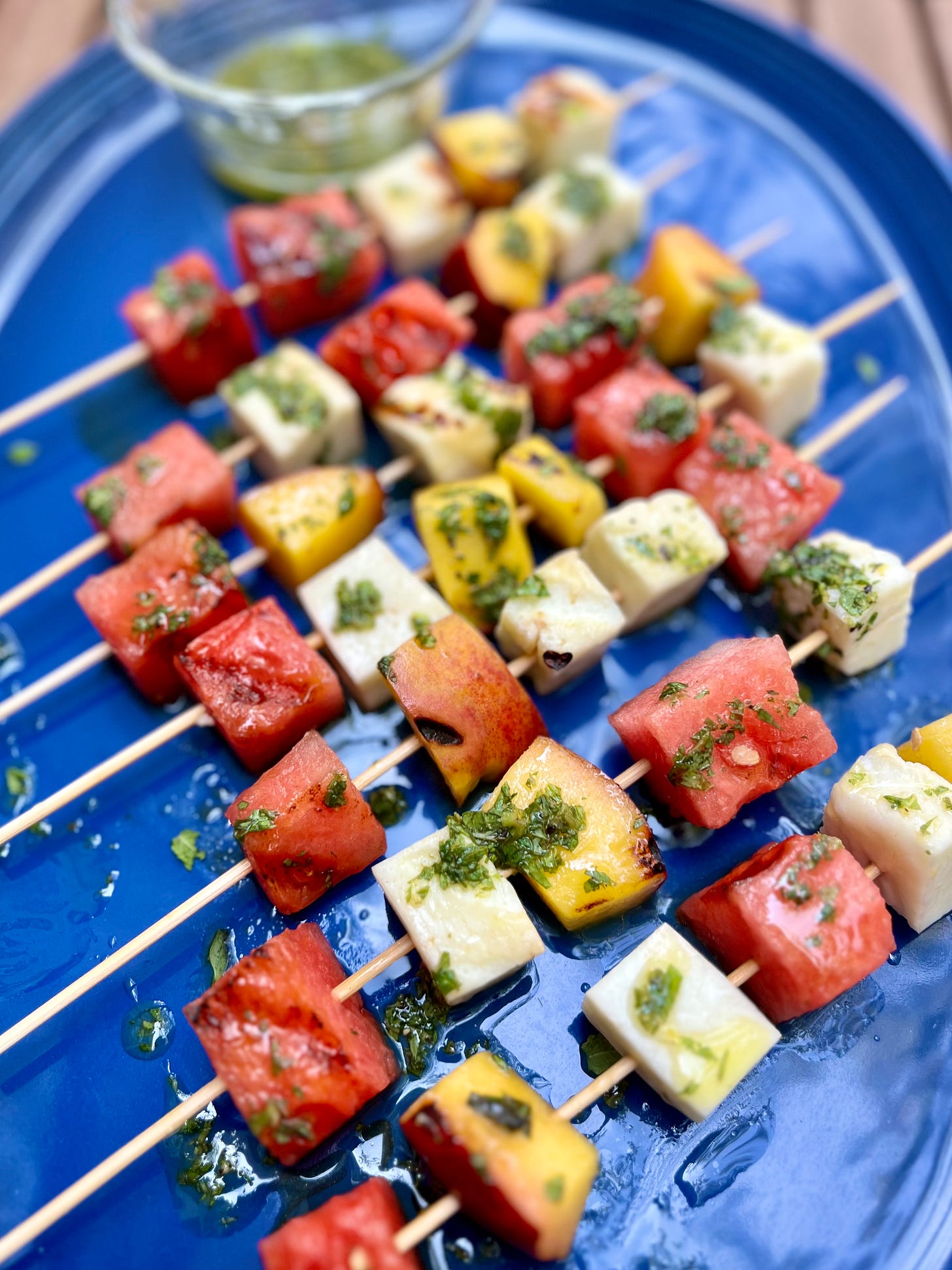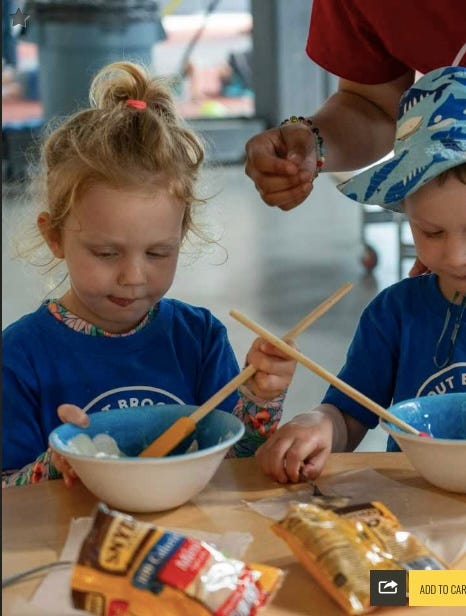

Discover more from The Jewish Table
Grilled Halloumi, Peach, and Watermelon Skewers
Plus: The Four Questions with Anya von Bremzen of National Dish
Hello The Jewish Table Readers!
This week, I am excited to share an interview with food writer Anya von Bremzen, and talk about her latest book National Dish: Around The World in Search of Food, History, and the Meaning of Home, which came out late last month. National Dish explores how certain foods become linked to specific places (think ramen and Japan, pizza and Italy, or mole and Mexico), and how the true story of a food’s connection to place is often not nearly as straightforward as we assume.
But before we get to that, I offer you a decidedly cross-cultural recipe for Grilled Halloumi, Peach, and Watermelon Skewers. We have officially entered the season of low-fuss, produce-forward cooking where we can lean on the vibrant flavors of fresh ingredients (rather than technique or other kitchen sorcery) to do the heavy lifting. Here, halloumi—the squeaky, briny, heat-resistant Cypriot cheese—is paired with fresh watermelon and peaches for a quick dance on the grill (or grill pan), transforming into an edible distillation of summer.
All of my watermelon-feta salad lovers already know the magic of combining the juicy summer melon with salty cheese. But the grill takes the experience to new heights. The watermelon pieces caramelize along the edges of the grill marks, adding sweetness and singe. The halloumi turns molten and tender. And the peach adds a welcome touch of tang to the sweetness. They are wonderful straight off the grill, but I like to gild the lily with a lemony mint oil drizzled over top.
Let me know if you make them, and how you make them your own!
Grilled Halloumi, Peach, and Watermelon Skewers
Serves: Flexible (scale up or down as needed for the crowd you’re feeding)
For the Mint Drizzle:
Finely chop 1/2 packed cup of fresh mint leaves and add them to a small bowl along with 1/4 cup extra-virgin olive oil, the zest of 1/2 a lemon, 1 teaspoon fresh lemon juice, 1/8 teaspoon of salt and freshly ground black pepper. Whisk to combine. Taste and add more salt / pepper / lemon juice as needed.
For the Skewers:
Cut halloumi, watermelon, and peaches into 1-inch cubes. (Approximate as best as you can with the peach, but aim to have everything as close to the same size as possible.) Thread the cheese and fruit onto skewers, then brush lightly with olive oil. Grill over a medium-high grill, or in a grill pan on the stove, turning every 1-2 minutes, until charred on all sides. Serve immediately, topped with the mint drizzle.
The Four Questions Interview: Anya von Bremzen
Welcome to the latest installment of The Four Questions, The Jewish Table’s semi-regular interview segment featuring Jewish food luminaries. This week I’m thrilled to be joined by Anya von Bremzen, a James Beard Award-winning food writer and author of six cookbooks, including her most recent National Dish: Around The World in Search of Food, History, and the Meaning of Home.
Anya has a way of taking wildly complex and nuanced subjects—like the intersection of food and national identity—and bringing them to life in a way that is both easily digestible (but not dumbed down) and can’t-put-the-book-down compelling. In National Dish she explores our '“compulsion to tie food to place,” and how the rise of globalization has made our connection to place feel “both more obsolete and more vital and relevant than ever.”
Anya travelled to France (for pot-au-feu), Naples (for pizza and pasta pomodoro), Tokyo (for ramen and rice), Seville (for tapas), Oaxaca (for maize, mole, and mezcal), and Istanbul (for mezze) to dig into how and why these dishes/ingredients became edible symbols of their locales—and why those might not be as strong or as ancient as we think. And in the book’s epilogue, she tackles borscht (or rather borsch because, as she explains, the “t” is a Yiddish addition)—a dish she grew up eating as a Russian immigrant in America, and which took on an entirely different meaning in the wake of Russia’s invasion of Ukraine.
Read on for Anya’s thoughts on the role industry has played in shaping our idea of national cuisine, how social media connects our palates across distance, . And for a summer read that is at once enlightening, informative, and an absolute delight to read, I enthusiastically recommend National Dish. (And for what it’s worth, her memoir Mastering the Art of Soviet Cooking is also an all-time favorite.)
Where do you think our desire to define our food identities comes from?
We live in such a globalized world where it can be easy to lose a sense of who you are. Food is such a perfect subject to infuse with whatever you want to, including identity, and I think it feels reassuring to have a connection to tradition. As I was writing my book, I was shocked to see how much of this kind of craving for nostalgia and regionalism goes back to the neoliberalism of the 1990s. That’s when big companies got involved in turning identities into commodities in a serious way. A lot of the foods that we think of as “traditional” are not nearly as old as we think they are. But we are still part of the narrative. If those foods are meaningful today, who is to say that they aren’t important?
How did you settle on which countries/dishes you wanted to focus on in National Dish? And what surprised you most about the places you focused on?
My original plan was a lot more ambitious—I originally had 12 chapters in mind. But my travels were limited by the pandemic, and I ended up focusing on the cultures I was more familiar with. I wanted to be able to bring some prior knowledge to my research, but also question that knowledge.
I was honestly surprised by everything. Like with pizza Margherita from Naples. The common origin story is that it was created in honor of Queen Margherita around the unification of Italy. That story is found in scholarly work. But digging deeper you realize it is complete “fake-lore.” And for something like ramen in Japan, the dish is still actively being invented. The idea of ramen as a national dish of Japan is intertwined with the development of regional tourism in the country. Starting in the 1980s, all of these iconic regional varieties of ramen began popping up and local authorities promoted them for tourism.
You write about the impact that influential cookbooks have had in codifying cuisines in France and elsewhere. Now that we are in the social media era, what impact do you think it will have on defining or blurring the national cuisine boundaries?
Cookbooks are very important documents because food is ephemeral and they capture a moment in time. But for most of history cookbooks were meant for certain classes and not reflective of the whole picture of how people cooked and ate. Now things are much more inclusive. And social media is interesting because it makes national cuisines transnational. Anyone can access dishes and techniques from an Indian food writer or Mongolian cook on social media. You don’t have to be able to speak or read the language, you can watch it. I think there is a good chance it will begin to change the idea of what is considered national.
How do you personally define “Jewish food”? And how has your relationship to it changed/evolved over time?
We were secular Jews in the Soviet Union. My mother’s mother gave up any sense of Jewishness to become a good socialist. But Jewishness in the Soviet Union was defined in ethnic, not religious terms. I had no idea until I was older that Judaism meant something more than a stamp on the fifth line of your passport. Although we did have a sense of being “the other” and faced a lot of antisemitism when we left in the 1970s.
The first time I celebrated Passover was in the United States. Today, a lot of my Jewish identity still comes from food. We are not practicing Jews, but we celebrate the holidays, my mom especially. She loves to cook Jewish dishes like gefilte fish and learned from trial and error. Because I live in Turkey for part of the year, I am also into Sephardi cuisine. That is more food I would cook for myself because I just like it.
Bonus Kid Camp Content!
Thank you so much for your kind and supportive comments and notes after last week’s emotional newsletter about sending Max off to sleep away camp. Thanks to the magic of digital photography, we have been able to get a few candid glimpses of his experience swimming, rock climbing, walking the camp’s goats (ah hippie Jewish summer camp!) and playing ukulele. I’m hopeful he’s soaking up the moments, and looking forward to hearing more when he gets home on Sunday.
Bea, meanwhile, is very much enjoying her time as a temporary only child. And also living her best summer life at day camp. Here she is stirring up some concoction that she described as “yucky but fun.”


















Leah, loved seeing Max at camp and Bea stirring up some trouble!! xo
I have National Dish in a big pile on my nightstand! The skewers look delicious, thanks for the fruit-cheese inspiration.